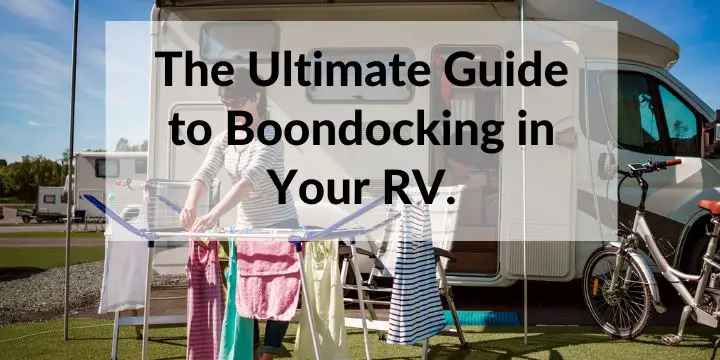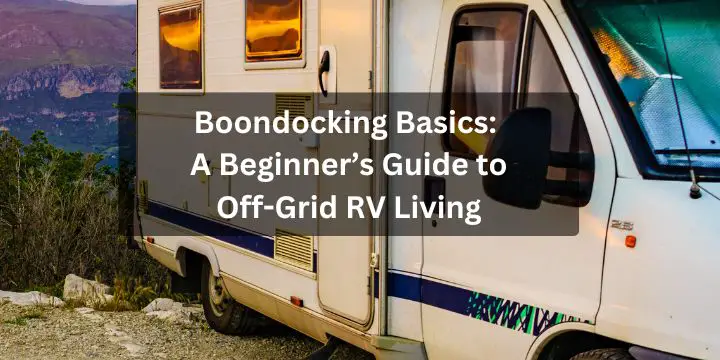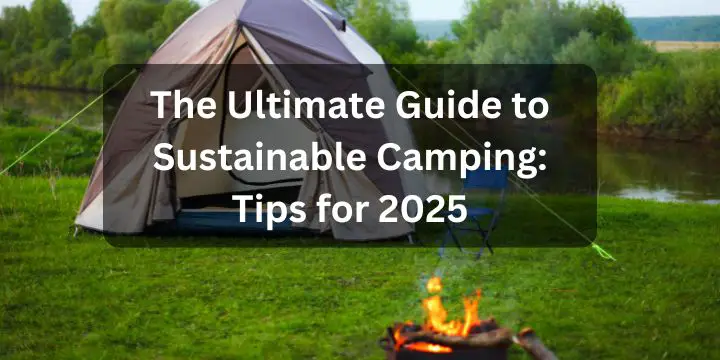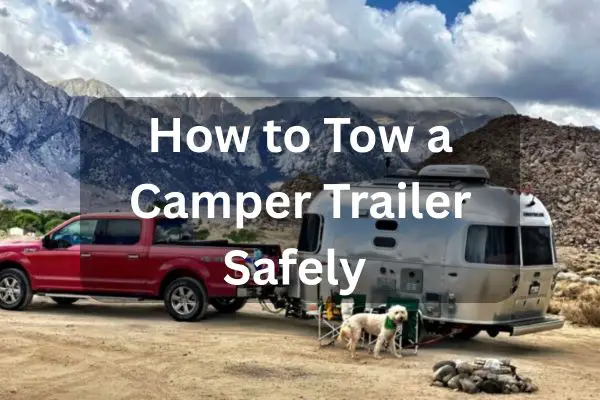
Boondocking, also known as dry camping or off-grid camping, is an exciting way to explore the great outdoors in your RV without the constraints of traditional campgrounds.
This form of camping allows you to park your RV in remote, scenic areas and experience nature in its purest form. In this guide, we’ll cover everything you need to know about boondocking, including finding the perfect spot, preparing your RV, and ensuring a safe and enjoyable experience.
What is Boondocking?
Boondocking refers to camping without hookups, such as electricity, water, or sewer connections. It typically takes place on public lands managed by agencies like the Bureau of Land Management (BLM) or the U.S. Forest Service, as well as other remote locations where camping is permitted. Unlike staying in developed campgrounds, boondocking allows you to camp for free or at a very low cost while enjoying seclusion and natural beauty.
Why Choose Boondocking?
There are several reasons why RV enthusiasts choose to boondock:
- Cost Savings: Boondocking is often free or very inexpensive compared to traditional campgrounds.
- Privacy: You’ll enjoy more privacy and less noise compared to crowded campgrounds.
- Scenic Locations: Boondocking spots are often in beautiful, remote areas with stunning views.
- Adventure: It adds an element of adventure and self-sufficiency to your RV travels.
Finding Boondocking Locations
Finding the perfect boondocking spot requires a bit of research and planning. Here are some resources and tips to help you locate great boondocking sites:
- Public Lands: Utilize public lands managed by the BLM, U.S. Forest Service, and other agencies. Websites like Recreation.gov and the BLM’s website provide information on available sites.
- Boondocking Apps: Apps like Campendium, iOverlander, and FreeRoam offer user-generated reviews and GPS coordinates for boondocking spots.
- Online Forums: Join RV forums and social media groups where fellow RVers share their favorite boondocking locations.
- Local Knowledge: Talk to locals, park rangers, and other RVers for recommendations on good spots.
- Scout Ahead: Use Google Earth or other mapping tools to scout potential sites before you arrive.
Preparing Your RV for Boondocking
Proper preparation is crucial for a successful boondocking experience. Here’s how to get your RV ready:
- Water Supply: Ensure your fresh water tank is full and carry additional water containers if needed. Consider investing in a portable water filtration system.
- Power Supply: Equip your RV with solar panels and a reliable battery bank to generate and store power. A generator can be a useful backup.
- Waste Management: Make sure your gray and black water tanks are empty before heading out. Use biodegradable products and minimize water usage to extend the time between dumps.
- Food and Supplies: Stock up on non-perishable food, cooking supplies, and any other essentials. Plan meals that require minimal preparation and water usage.
- Safety Gear: Bring a first aid kit, tools, and emergency supplies. Make sure your RV’s tires and mechanical systems are in good condition.
Sustainable Boondocking Practices
Boondocking allows you to enjoy nature, so it’s important to minimize your impact on the environment. Here are some sustainable practices to follow:
- Leave No Trace: Follow the Leave No Trace principles by packing out all trash, minimizing campfire impact, and respecting wildlife.
- Conserve Water: Use water sparingly. Take shorter showers, turn off the tap while brushing your teeth, and use biodegradable soaps.
- Energy Efficiency: Use energy-efficient appliances and LED lights to conserve power. Turn off devices when not in use.
- Stay on Established Paths: Avoid creating new paths or campsites. Use existing roads and campsites to protect vegetation and wildlife habitats.
Boondocking Safety Tips
Safety is paramount when boondocking, as you’ll often be far from emergency services and amenities. Here are some tips to ensure a safe experience:
- Inform Others of Your Plans: Always let someone know your location and expected return date. This way, if something goes wrong, they can alert authorities.
- Stay Connected: While you may be off-grid, having a means of communication like a satellite phone or a personal locator beacon can be a lifesaver.
- Know the Weather: Check the weather forecast before heading out and be prepared for sudden changes. Extreme weather can pose significant risks when you’re boondocking.
- Fire Safety: If you plan to have a campfire, make sure it’s in a safe, designated area and always extinguish it completely before leaving or sleeping.
- Wildlife Awareness: Be aware of local wildlife and know how to store food properly to avoid attracting animals to your campsite.
The Benefits of Boondocking
Boondocking offers a unique blend of benefits that can enhance your RV travel experience. Here’s why many RVers love it:
- Freedom and Flexibility: Without the need for reservations or hookups, you have the freedom to choose your own schedule and destination.
- Cost Efficiency: By avoiding campground fees, you can save a significant amount of money, allowing you to travel longer or allocate your budget to other experiences.
- Deeper Connection with Nature: Boondocking brings you closer to nature, offering a serene and immersive experience that’s hard to match in a traditional campground setting.
- Enhanced Self-Reliance: Managing your own resources and utilities fosters a sense of independence and self-reliance, making the experience more rewarding.
Common Challenges of Boondocking
While boondocking is rewarding, it comes with its own set of challenges. Here’s how to address some common issues:
- Resource Management: Carefully monitor your water, power, and waste levels. Learning to conserve and manage these resources is crucial for a successful boondocking trip.
- Limited Connectivity: Internet and cell service may be unreliable. Plan ahead by downloading maps and entertainment, and prepare for periods without connectivity.
- Isolation: Being far from help can be daunting. Always have a plan for emergencies and know the nearest locations for fuel, water, and supplies.
- Environmental Impact: Be mindful of your environmental footprint. Follow sustainable practices to ensure these beautiful sites remain pristine for future generations.
Essential Boondocking Gear
Equipping your RV with the right gear can make boondocking more comfortable and efficient. Here’s a list of essentials:
- Solar Panels: To generate renewable energy and reduce reliance on generators.
- Portable Generator: As a backup power source for cloudy days or high energy needs.
- Water Filtration System: To ensure a safe and continuous water supply.
- Extra Fuel and Water Containers: To extend your stay and provide emergency reserves.
- Portable Toilet: For added convenience, especially in locations without amenities.
- First Aid Kit: To handle minor injuries and emergencies.
- Tool Kit: For repairs and maintenance on the road.
- Fire Extinguisher: For safety in case of fire emergencies.
Planning Your First Boondocking Trip
Planning your first boondocking trip can be overwhelming, but with careful preparation, you can ensure a smooth experience. Here’s a step-by-step guide:
- Research Locations: Use the resources mentioned earlier to find a suitable spot. Check for accessibility and any regulations or restrictions.
- Prepare Your RV: Ensure your RV is in good working condition, with full tanks and necessary gear.
- Pack Wisely: Bring all essential supplies, including food, water, clothing, and safety gear.
- Plan Your Route: Have a clear route to your boondocking location, and plan for fuel stops along the way.
- Monitor Conditions: Keep an eye on weather and road conditions, adjusting your plans as necessary.
The Boondocking Community
Boondocking has a vibrant community of enthusiasts who share tips, locations, and experiences. Engaging with this community can enhance your boondocking adventures. Here’s how to get involved:
- Online Forums and Social Media: Join groups and forums dedicated to boondocking. Share your experiences and learn from others.
- Boondocking Meetups: Attend meetups and rallies to connect with fellow boondockers, exchange tips, and make new friends.
- Local Clubs: Many areas have local RV clubs that organize boondocking trips and events.
Conclusion
Boondocking is a fantastic way to explore the beauty of the great outdoors while enjoying the freedom and flexibility that RV travel offers. By preparing your RV, following sustainable practices, and embracing the adventure, you can create memorable and fulfilling boondocking experiences.
FAQs
- What is the difference between boondocking and dry camping?
- Boondocking typically refers to camping in remote, undeveloped areas without hookups, often on public lands. Dry camping, on the other hand, can occur in any location without hookups, including parking lots or developed campgrounds.
- Is boondocking safe?
- Yes, boondocking can be safe if you take the necessary precautions. Always inform someone of your plans, stay aware of your surroundings, and be prepared for emergencies.
- How do I find water while boondocking?
- You can fill your water tanks at gas stations, rest areas, and campgrounds that offer water services. Additionally, carrying portable water containers and a filtration system can be helpful.
- Can I boondock in any RV?
- While any RV can be used for boondocking, some are better suited than others. Smaller RVs, like Class B and C motorhomes or travel trailers, are often more maneuverable and can access more remote locations.
- How long can I boondock?
- The duration of your boondocking trip depends on your resource management. With careful planning, you can boondock for several days to a couple of weeks. The key is to monitor your water, power, and waste levels and plan accordingly.
Most RV beginners learn this the hard way. Don’t.
🚐 Start RV Living the Right Way (Instant Download)Instant download • Secure checkout • Beginner-friendly


